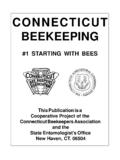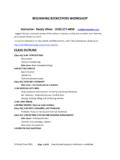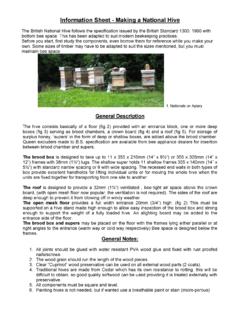Transcription of INVESTMENT IN THE BEEKEEPING SUB-SECTOR
1 INVESTMENT IN. THE BEEKEEPING . SUB-SECTOR . Prepared by: The Apiculture Unit August 2013. Status of the BEEKEEPING Industry The BEEKEEPING Industry in Jamaica is the fastest growing of the subsectors in agriculture at this time. Within the last four years (2005-2009) the Industry has had: a. >100% increase in beehive population b. 60% increase in beekeepers c. 71% increase in apiaries As the demand for products of the beehive increase (resulting from improved awareness of the values of these products) more individuals recognise the need to satisfy this demand. The short term returns on INVESTMENT is also another attractant to new investments. These returns are rivalled only by a very small number of the INVESTMENT opportunities in the Agricultural Sector.
2 BEEKEEPING however has some distinct advantages such as: - It does not require large acreages to establish an apiary - It is not labour intensive - Other activities can run concurrently with moderate operations - Most activities in the apiary are timely - The returns on INVESTMENT can be significant (though heavily dependent on the level of management). - Bees do not compete with man nor other animals for food - That which is gathered and converted by the bees for the use of man could not otherwise be economically harnessed. The cost to establish an apiary at the economic unit (50 hives) initially may be considered relatively high. This however is associated with the high cost of BEEKEEPING equipment whether imported or locally produced.
3 Identification and Sourcing of Bee stock Jamaica possesses a honeybee derived from three races of the Aphis mellifera spp. These races include the Italian honeybee (Aphis mellifera lingustica,) Caucasian honeybee (Aphis mellifera caucasica) and the German black bees (Aphis mellifera mellifera). Physical features of these genetic lines are evident in any colony of honeybees in Jamaica. It is therefore difficult to find a colony which is pure, that is, of one specific race. Sourcing Bees In sourcing stock for the establishment of a new apiary, it is imperative that careful selection be undertaken in order to ensure genetic qualities of any particular line.
4 Not all honeybees possess the same level of genetic characteristic and poor quality queens produce poor quality offsprings. Very few beekeepers in Jamaica keep accurate record or any record whatsoever. Therefore, physical examination of the beehives must be done for selection. Inspection for pest status is another factor, as high infestation levels of varroa mites, small hive beetle or the wax moth may result in early loss of colonies. The American Foulbrood disease must be avoided at all cost as there is no cure or recommended treatment for this disease. Infected colonies therefore must be promptly destroyed. Your Apiculture Extension Specialist operating from the Research and Development Division of the Ministry of Agriculture and Fisheries must be contacted for assistance when making a purchase of bees.
5 (See listing on site). Local Market The sale of honey in Jamaica is traditionally measured by a 5-gallon pail, which currently fetches $12,000 at the farmgate. The 750 ml bottle which is widely used (and must be discouraged) fetches upward of $800 each at the retail price. Each gallon of honey contains x 750 ml bottles. Local demand is nowhere near saturation point and the demand for Jamaica's honey abroad is high. A facility established to purchase honey from farmers will soon begin to export large quantities of the product to North America and Europe. This facility, located at Linstead in St. Catherine is equipped with state of the art machinery for blending, filtering, settling, packaging and labelling.
6 These equipment however will be relocated soon to a more appropriate building. It is envisioned that approximately 35%. of current honey produced will be exported through the bottling plant. The plant provides a ready market for any quantity of honey. Other individuals and companies are also intending to get involved in the export of honey. On the other hand, the local demand is being supplied by beekeepers directly in retail outlets such as supermarkets and health food stores while a large percentage is sold by higglers. Other suppliers purchase large quantities from the farmers, label retail containers and sell through various outlets. The hotels have not been strategically targeted.
7 Packaging Diversifying quantities/amounts target end users at varying economic levels. This increases sale of the products and generates more returns on investments. The packaging and labelling must be attractive and in line with established standards. Creating and producing value-added products from the beehive have great potential as these are sought after for medicinal, cosmetic and food purposes. Products of Beehive The products of a beehive are diverse and all are of economic importance. Each product commands good wholesale/ retail prices. Product Average annual Current cost Market production / hive Honey 8-12 gls ( ) $2400/gal Local, North ($4210/kg) America & Europe Bee Pollen 35lbs ( ) / hive $3300 - $4000 / Local & Foreign kg Propolis lb ( ) / hive $6650 / kg Europe Royal Jelly - US$80 / once Local & Foreign Queen Bees Dependent on size of $1200 each Local operation US$25 each North America Packaged bees US$180 / kg North America Beehive single $12,000 - Local $15,000.
8 Bee Venom - - Bees wax / $1760 Local hive/year When one contemplates BEEKEEPING for profitable production, it must be pre-determined what products are to be produced. The production of several hive products can run concurrently with insignificant negative impact on any one. The following table identifies the products and current market prices as well as possible markets Cost of Production Proposed Unit Unit Cost Total Cost Procurement Bee Hives/Colonies 25 13,000 325000. Hive Bodies 50 950 47,500. Hive Covers 15 600 9,000. Bottom Boards 15 650 9750. Queen Excluders 25 900 22500. Bee Frames 650 90 58500. Comb Foundation 37kg 2860 105820. Bee Veil 2 5000 10000.
9 Bee Smoker 1 9000 9000. Hive Tool 1 1100 1100. Honey Extractor 1 *4 frames 120000 120000. 715850. Establishing the Apiary Step 1: Establish apiary of ten (10) colonies of honey bees Mount each hive at two 6 block height using four 6 blocks Add one hive body each complete with frames in comb foundation Treat each hive with two strips of Apistan for Varroa mite Allow bees to build out foundation into comb over 4 weeks Step 2: Supering hives After each hive body of comb foundation has been completely built out with combs, place the third hive body similarly prepared on to the hive. Allow bees to fill out 50% of foundation sheets. Place Queen excluder between the 2nd and the 3rd hive body (from ground).
10 Check for honey storage in super. A third hive body may be added if funds allow. Ensure that the queen bee is kept below the queen excluder. Step 3: Progressive Expansion After the honey flow (February April), remove one brood chamber from each hive and place it in similar pattern except that the entrance is turned @ 180 0 angle from parent hive. Ensure that eggs/open brood are in both brood chambers with high population of worker bees. Remove the queen excluder, replace the honey super *. Step 4: Brood chambers; boxes below queen excluder Apiary now consists of 50 colonies Feed colonies with sugar syrup to encourage brood production and prevent starvation Step 5: Week # 6 after splitting hives Thoroughly inspect combs for queen cells Hive with queen cells indicate queenless colony.



